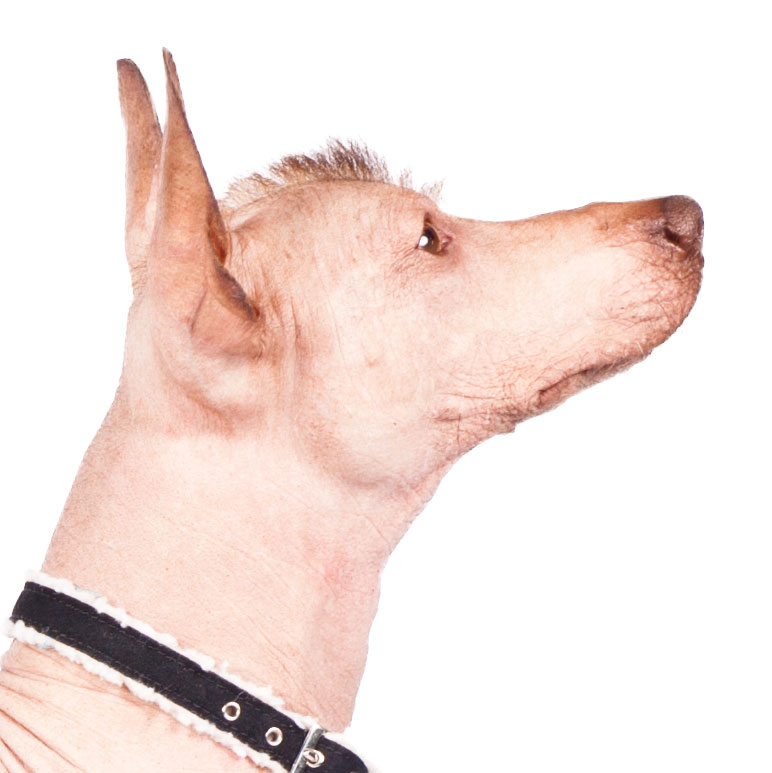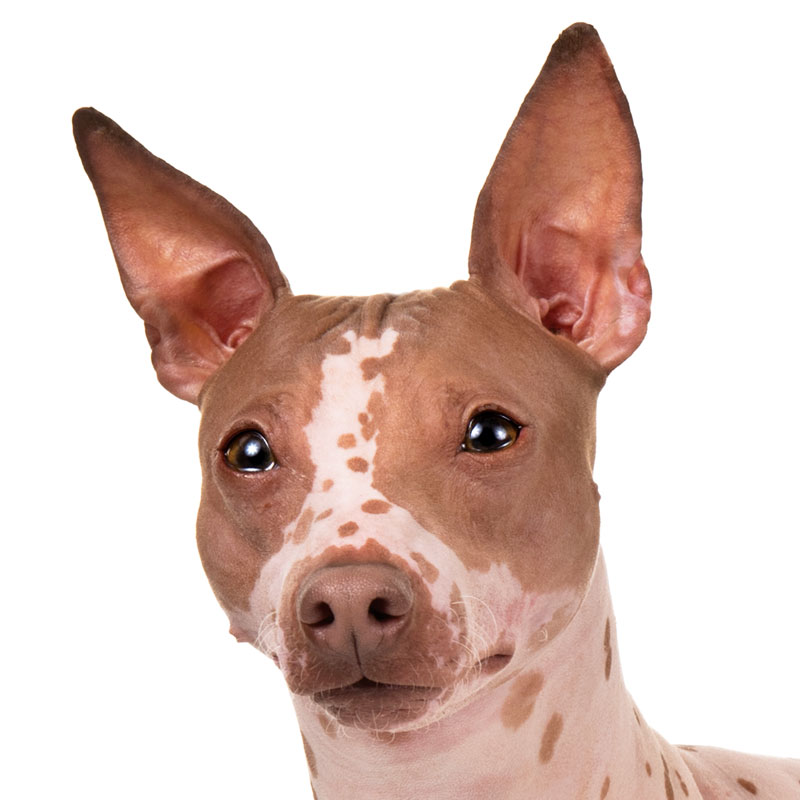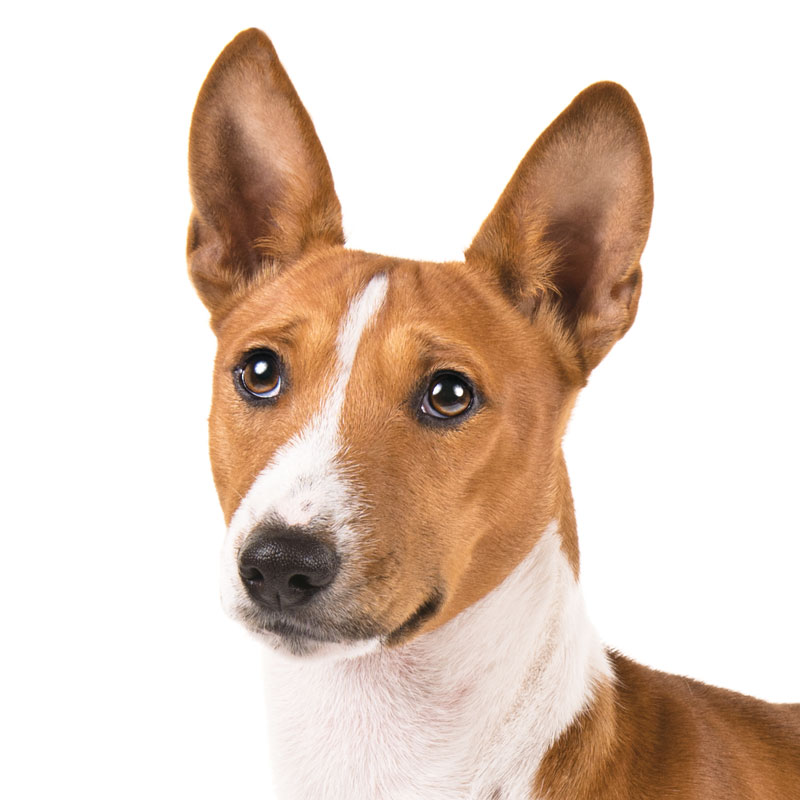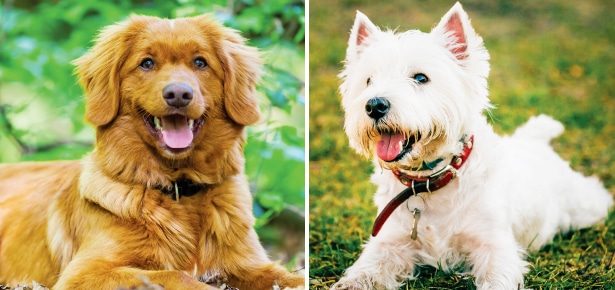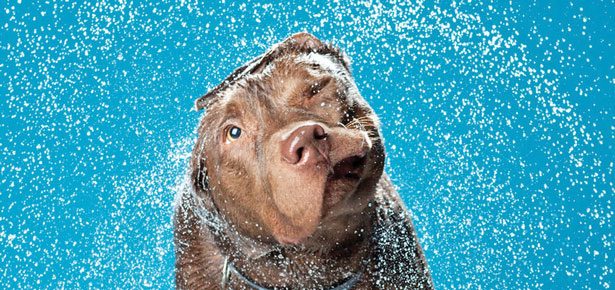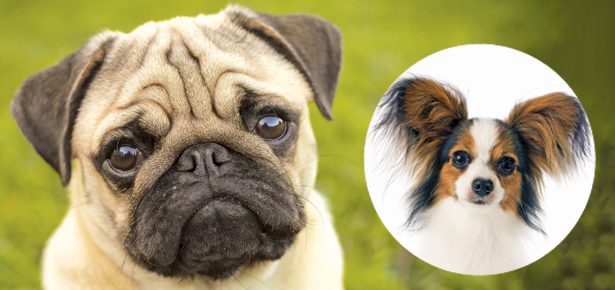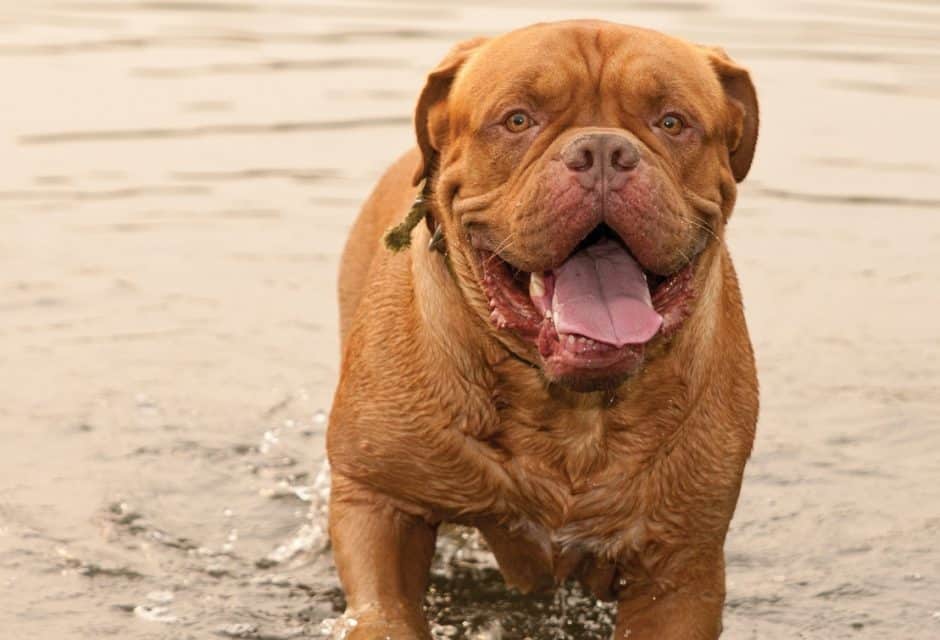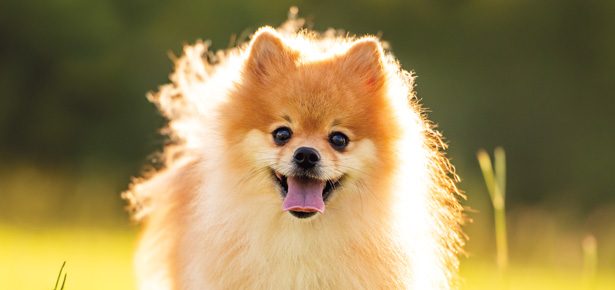
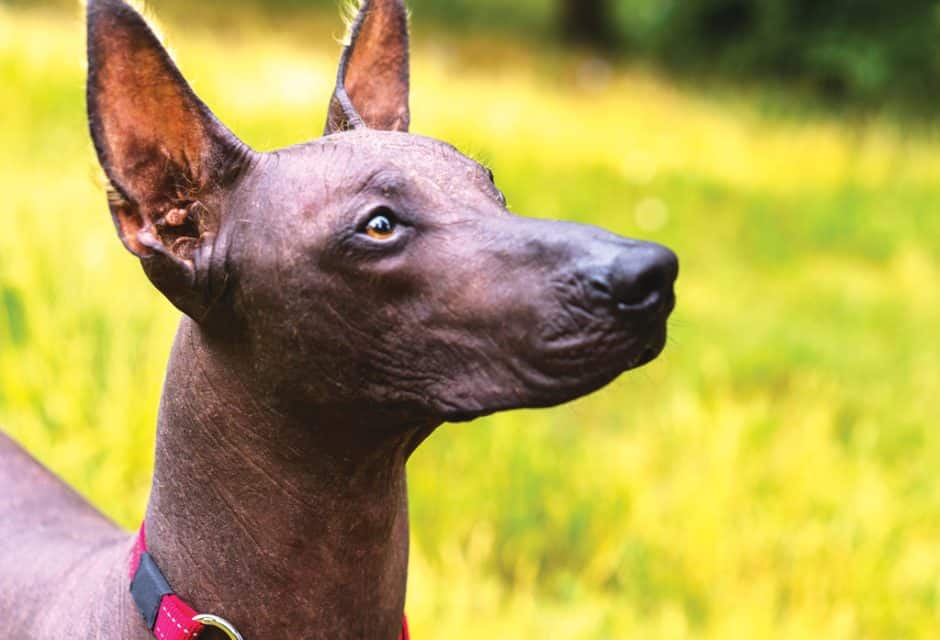
The Xoloitzcuintli
The Xoloitzcuintli (pronounced SHOW-low-eats-QUEENT-lee) is one of the world’s oldest and rarest breeds.

With his striking appearance and generally-hairless body, the Xoloitzcuintli is certainly one of the most unique dogs you’ll ever see. As it turns out, the breed’s fascinating history is just as unique.
How do you pronouce pronounced Xoloitzcuintli? Simply–show-low-eats-queent-lee—is derived from the Nahuatl language. Xolotl is the Aztec god of life and death, and itzcuintli translates as dog. Bit of a mouthful, isn’t it? That’s why, most often, he’s referred to by his shortened name: the Xolo.
Outside of Mexico and Central America, the Xoloitzcuintli is considered rare. One of a number of primitive, natural breeds, the Xolo wasn’t created to look or act a certain way; he simply “was,” and then he continued to evolve.
So how and where did the breed originate? As with all of the ancient breeds, there is a lot of guesswork, but there’s also a good body of evidence to suggest that this is a uniquely-native Mexican breed. We do know that the Xolo has been in existence for more than 3,000 years. Archaeological digs at Aztec ruins have uncovered bones deemed likely to come from these dogs. Drawings and artifacts depicting Xolo-like dogs have also been found in the tombs of the Mayans, Toltec, Zapoteca, and Colima Indians.
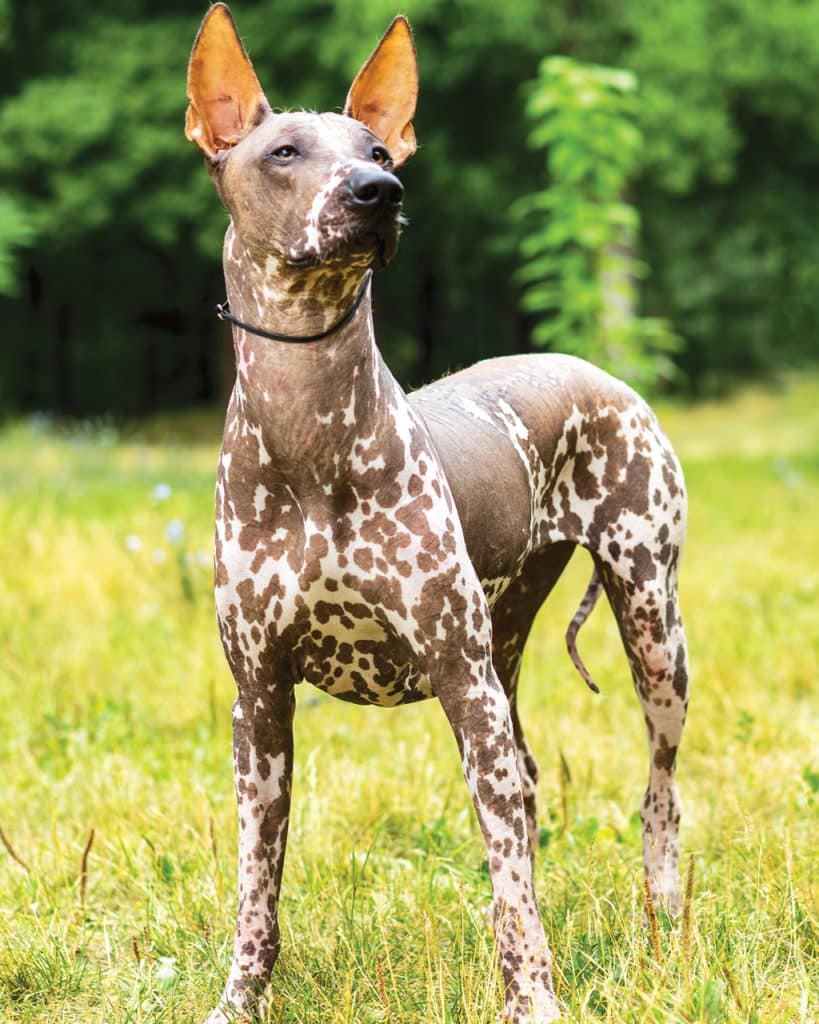
Masarik/Bigstock
In Mexican and Central American culture, the Xoloitzcuintli has long been a culturally-significant symbol. These dogs were considered sacred by the Aztecs and the Mayans, both of whom believed that Xolotl had created them and granted them mystical powers to ward off evil spirits. In addition, it was believed the Xoloitzcuintli could serve as a guide to the underworld. For this reason, Xolos were often sacrificed and buried next to their deceased owners in order to help them journey to the afterlife and continue their bond eternally.
The Xoloitzcuintli’s cultural significance has not waned. Famed artists Diego Rivera and Frida Kahlo both had Xolos as pets and incorporated these dogs into their artwork.
In terms of their progression beyond Mexico’s borders, the Xolo was first registered in The American Kennel Club (AKC) studbook as the Mexican Hairless back in 1887.
They remained known by that moniker for some time. The breed was so rare in the United States, though, that numbers dwindled significantly, and the Mexican Hairless was de-listed by the AKC in the 1950s.
Xoloitzcuintli fanciers recognized the breed was at risk and took action. They set forth and searched the farthest and most remote regions of Mexico in search of archetypal dogs. In the end, they returned with ten Xolos that matched the standard they sought to further. The Mexican Kennel Club (FCM) recognized the breed in 1956, but it wasn’t until 2011 that the AKC accepted the Xoloitzcuintli.
Most Popular Dogs in the US
According to the most recent AKC registration statistics
[1] Labrador Retriever
[2] German Shepherd
[3] Golden Retriever
[4] French Bulldog
[5] Bulldog
[6] Beagle
[7] Poodle
[8] Rottweiler
[9] YorkshireTerrier
[10] Pointers
[140] Xoloitzcuintli
Today, the AKC accepts the breed in three sizes: Standard, Miniature, and Toy. Toys are accepted at a height of 10 to 14 inches at the withers (shoulder); Miniatures are 14 to 18 inches at the withers, and the Standards can be 18 to 23 inches at the withers. In all three sizes, the breed is characterized by a sleek body, almond-shaped eyes, a very long, pointy nose, and oversized ears. In some ways, he looks like a version of a Pharaoh Hound, but of course it’s his lack of fur that serves as his most unique physical trait.
That being said, the Xolo is not entirely hairless… or hairless at all, in some cases. Most Xoloitzcuintlis are hairless except for small tufts of hair on their heads, feet, and tips of their tails. However, roughly one in five are born with a coat of short, smooth fur. The AKC standard prefers a dark, uniform coat colour, but the breed is accepted in black, grey black, slate, red, liver, or bronze.
Xoloitzcuintli (pronounced “show-low-eetz-queent-lee”) is a combination of the name of the Aztec God of lightning and death, “Xolotl,” and the Aztec word for dog, “itzcuintli.”
This rare breed’s recognition has increased after the release of Pixar’s animated film Coco, which features a clumsy but lovable Xolo. ‘Dante’ serves as a goofy-but-heroic sidekick to the movie’s protagonist—a fitting choice, given that the Xolo is a prominent feature in the festivities of Dia de los Muertos, the celebration serving as the central background to the film.
Spiritual history and modern films aside, what’s it like to live with one of these dogs? The answer is that he’s incredibly easy to be around. The Xoloitzcuintli is calm, affectionate, and playful. He’s quiet, keeps himself quite clean, and loves to snuggle. The Xolo is a dog who, really, just wants to “be” with you.
These all-star cuddlers set the bar high for other dogs. Xolos run hot; they literally radiate quite a lot of heat. Your cuddle time may leave you feeling like you’re cozied up to a hot-water bottle! That extra heat they disperse is often cited as a possible reason the Xolo was thought to have mystical healing powers.
Profile: The Xoloitzcuintli
Size: Small to Medium
Xolos come in three sizes: Toy, Miniature, and Standard. They range from 10″ to 23″ tall at the withers, and are roughly 10 to 50 pounds. Xolos also come in coated and hairless varieties.
Activity Level: 3/5
While they’re agile and athletic, the easygoing Xolo will be happy with daily walks, and some play-time on the home front.
Grooming: 3/5
This is a fairly low-maintenance breed, but the hairless varieties do need regular bathing and applications of non-oily moisturizer.
Heritage: Non-Sporting
A primitive, natural breed, he was used as a hunting companion and family companion in his native home of Mexico and throughout Central America.
For more information on Xolo rescue in the US and Canada, visit xoloitzcuintliclubofamerica.org/xolo-rescue.
While they’re more apt to be snuggling with you or sleeping in a sunny spot, the Xolo is no couch potato. They’re actually quite an athletic and agile breed and were originally used to assist their owners in hunting small game. For that reason, like many of the primitive breeds, a good amount of that “wild child” lingers. They can be prone to chasing smaller animals, and the agile Xolo is able to scale or jump fences. For escape artists like this, a fenced-in yard is advised.
Training from an early age will help ensure you’ve got a well-manned pup in the house. The Xoloitzcuintli is smart, but they’re sensitive. Positive reinforcement training techniques are the only logical course for this (and every) breed. They learn quickly and want to please you. Be firm and consistent in your training efforts, but be patient and be kind—this special dog deserves nothing less.
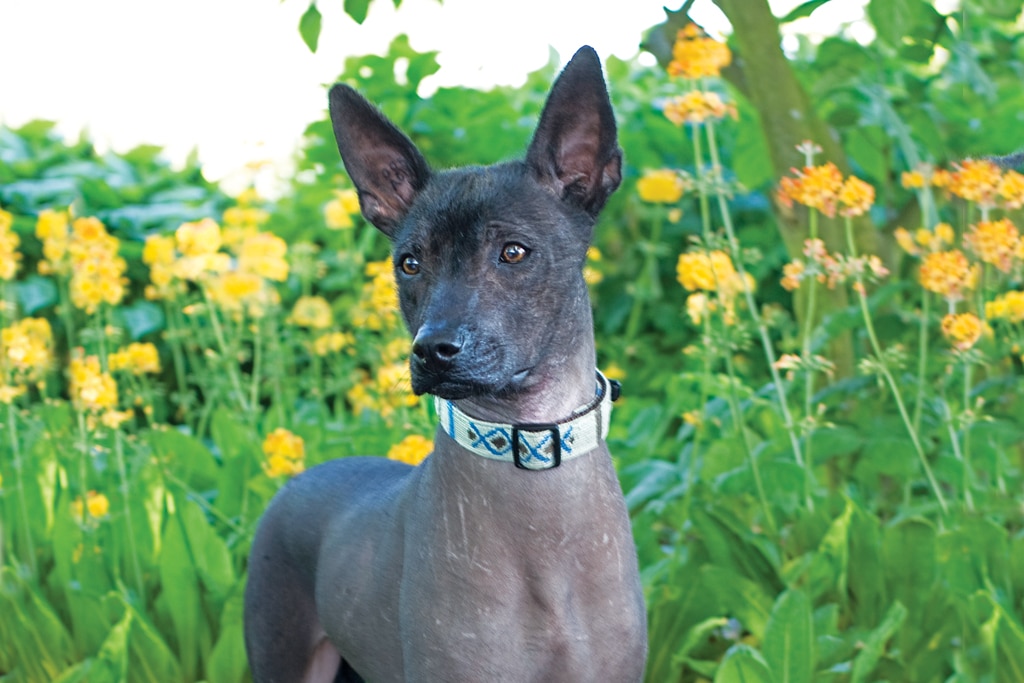
Dog: Kahlo; A Tail We Could Wag hand-woven Mayan-inspired collar; tailwags.com
In terms of health, they’re a hearty breed but, without the protection of a coat of fur, the Xolo does need some extra care. Their coat will need washing and moisturizing, and sunburn is a risk. Since Xolos are born with an incomplete set of teeth, keeping tabs on dental health is also important.
So many wonderful things have come from Mexican and Central American culture, and this breed is no exception. Mystical healer, spiritual guide—the ancient legends persist today, and that’s no doubt in part due to just how endearing the Xolo is. Their needs are simple and their demands are few. The Xoloitzcuintli has earned their status as a cultural icon.
If you like the Xoloitzcuintli, you might also consider the:
Peruvian Inca Orchid American Hairless Terrier Basenji
» Read Your Breed For more breed profiles, go to moderndogmagazine.com/breeds
Join the newsletter and never miss out on dog content again!
"*" indicates required fields
By clicking the arrow, you agree to our web Terms of Use and Privacy & Cookie Policy. Easy unsubscribe links are provided in every email.
